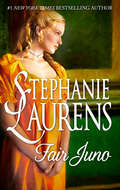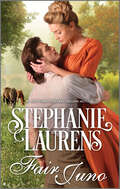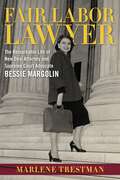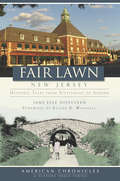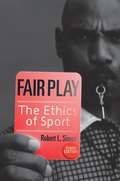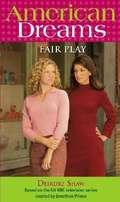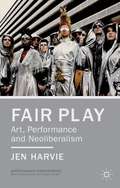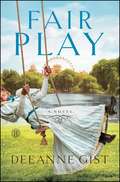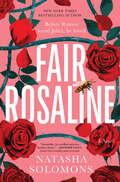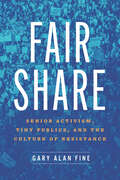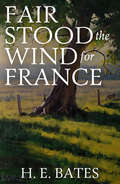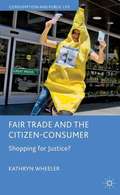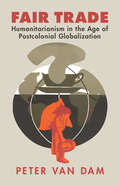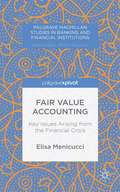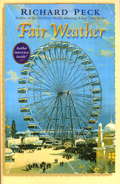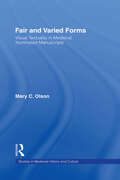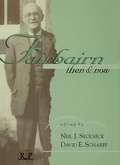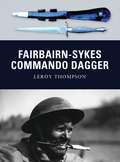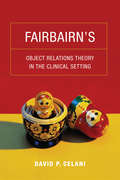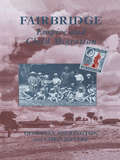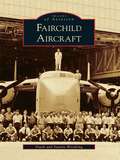- Table View
- List View
Fair Juno
by Stephanie LaurensA fan favorite! #1 New York Times bestselling author Stephanie Laurens takes your breath away with this charming romance... When the Earl of Merton suddenly finds himself playing the knight in shining armor to a damsel in distress, he knows his days as a notorious rake are numbered. But though the lady seems grateful for his assistance, she flees the scene without revealing her name. And though past scandals and present dangers threaten his pursuit of the mysterious lady, he knows she is to be his destiny.
Fair Juno (Mira Ser. #No. 13)
by Stephanie LaurensA widow rescued from kidnappers finds herself at the mercy of her seductive protector in this Regency romance from a New York Times–bestselling author.When the Earl of Merton suddenly finds himself playing the knight in shining armor to a damsel in distress, he knows his days as a notorious rake are numbered. But though the lady seems grateful for his assistance, she flees the scene without revealing her name. And though past scandals and present dangers threaten his pursuit of the mysterious lady, he knows she is to be his destiny.Praise for Stephanie Laurens“Laurens’ writing shines.” —Publishers Weekly“Stephanie Laurens’ heroines are marvelous tributes to Georgette Heyer: feisty and strong.” —Cathy Kelly, #1 Sunday Times–bestselling author of The Wedding Party“All I need is her name on the cover to make me pick up the book.” —Linda Howard, New York Times–bestselling author of An Independent Wife
Fair Labor Lawyer: The Remarkable Life of New Deal Attorney and Supreme Court Advocate Bessie Margolin (Southern Biography Series)
by Marlene TrestmanThrough a life that spanned every decade of the twentieth century, Supreme Court advocate Bessie Margolin shaped modern American labor policy while creating a place for female lawyers in the nation's highest courts. Despite her beginnings in an orphanage and her rare position as a southern, Jewish woman pursuing a legal profession, Margolin became an important and influential Supreme Court advocate. In this comprehensive biography, Marlene Trestman reveals the forces that propelled and the obstacles that impeded Margolin's remarkable journey, illuminating the life of this trailblazing woman. Raised in the Jewish Orphans' Home in New Orleans, Margolin received an extraordinary education at the Isidore Newman Manual Training School. Both institutions stressed that good citizenship, hard work, and respect for authority could help people achieve economic security and improve their social status. Adopting these values, Margolin used her intellect and ambition, along with her femininity and considerable southern charm, to win the respect of her classmates, colleagues, bosses, and judges -- almost all of whom were men. In her career she worked with some of the most brilliant legal professionals in America.A graduate of Tulane and Yale Law Schools, Margolin launched her career in the early 1930s, when only 2 percent of America's attorneys were female, and far fewer were Jewish and from the South. According to Trestman, Margolin worked hard to be treated as "one of the boys." For the sake of her career, she eschewed marriage -- but not romance -- and valued collegial relationships, never shying from a late-night brief-writing session or a poker game. But her personal relationships never eclipsed her numerous professional accomplishments, among them defending the constitutionality of the New Deal's Tennessee Valley Authority, drafting rules establishing the American military tribunals for Nazi war crimes in Nuremberg, and, on behalf of the Labor Department, shepherding through the courts the child labor, minimum wage, and overtime protections of the Fair Labor Standards Act of 1938. A founding member of that National Organization for Women, Margolin culminated her government service as a champion of the Equal Pay Act, arguing and winning the first appeals. Margolin's passion for her work and focus on meticulous preparation resulted in an outstanding record in appellate advocacy, both in number of cases and rate of success. By prevailing in 21 of her 24 Supreme Court arguments Margolin shares the elite company of only a few dozen women and men who attained such high standing as Supreme Court advocates.
Fair Lawn, New Jersey: Historic Tales from Settlement to Suburb
by Jane Lyle DiepeveenIn Fair Lawn, New Jersey, the layered heritage is clear from the mix of Native American, Dutch and English names adorning its street signs. Author Jane Lyle Diepeveen traces Fair Lawn's history from its origins as a settlement at Sloterdam, a site of the developing Dutch Colonial architecture, to the innovative neighborhoods of Radburn, a cutting-edge planned American garden city. Through interviews with longtime Fair Lawn residents, Diepeveen honors the days of dairy farms and swimming holes, as well as this vibrant community's progress today. From Warren Point to Columbia Heights, Fair Lawn reveals the hidden story of this jewel of New Jersey.
Fair Play
by Robert L. SimonIn this updated third edition, Simon (philosophy, Hamilton College) provides a philosophical analysis of the ethics of competitive athletics. A critique of moral and ethical relativism is offered in the introductory chapter in order to establish the justifiability of moral judgments made in subsequent sections. Simon defends competition against its critics as being, ideally, a "mutual quest for excellence," as opposed to a mere manifestation of selfishness, and he applies internal and external hypotheses as regards the origin of sports morality to particular issues of sportsmanship and fairness. New to the third edition is an examination of genetic enhancement and sports. Other moral and ethical issues and dilemmas explored include the use of performance-enhancing drugs, gender equity in sports, the commercialization of sports, violence, collegiate athletics, and the role of sports in moral education. Annotation ©2011 Book News, Inc. , Portland, OR (booknews. com)
Fair Play
by Robert L. SimonAddressing both collegiate and professional sports, the updated edition of Fair Play explores the ethical presuppositions of competitive athletics and their connection both to ethical theory and to concrete moral dilemmas that arise in actual athletic competition. A major new section in chapter four examines the ethics of genetically enhancing athletic abilities. Other new material covers the analysis of sports and games according to influential philosopher Bernard Suits; the morality of cheating and the ethics of strategic fouling; and the impact of performance-enhancing drugs on the legitimacy of records. In addition, Simon provides enhanced considerations of the morality of competition in sports, the ethical aspects of violence in sports, and the arguments in defense of intercollegiate sports.
Fair Play (American Dreams)
by Deirdre ShawMeg Pryor is about to give up on trying to come up with the perfect plan for her date with Drew when she notices a flier for the annual St. Catherine's Spring Fair. Meg can't imagine a better night than cuddling with Drew on the Ferris wheel, and despite her best friend Roxanne's warning that a college guy might not be thrilled about attending a church fair, Meg has her heart set on going -- after all, the Pryors have gone every year since before Meg was born, and she's not going to miss it. Meg is devastated to learn that the fair is in danger of closing unless attendance picks up -- and with Bob Dylan playing in town, things don't look good for St. Catherine's. Meg is determined to find a way to save the fair. But with American Bandstand commitments, boyfriend dilemmas, and a best friend who is always getting her into trouble, will Meg be able to impress Drew and save the fair?
Fair Play – Art, Performance and Neoliberalism
by Jen HarvieThis book asks what is the quality of participation in contemporary art and performance? Has it been damaged by cultural policies which have 'entrepreneurialized' artists, cut arts funding and cultivated corporate philanthropy? Has it been fortified by crowdfunding, pop-ups and craftsmanship? And how can it help us to understand social welfare?
Fair Play: A Novel
by Deeanne GistFrom the bestselling author of It Happened at the Fair comes a historical love story about a lady doctor and a Texas Ranger who meet at the 1893 Chicago World's Fair.Saddled with a man's name, the captivating Billy Jack Tate makes no apologies for taking on a man's profession. As a doctor at the 1893 Chicago World's Fair, she is one step closer to having her very own medical practice--until Hunter Scott asks her to give it all up to become his wife. Hunter is one of the elite. A Texas Ranger and World's Fair guard specifically chosen for his height, physique, character, and skill. Hailed as the toughest man west of any place east, he has no patience for big cities and women who think they belong anywhere but home... Despite their difference of opinion on the role of women, Hunter and Billy find a growing attraction between them--until Hunter discovers an abandoned baby in the corner of a White City exhibit. He and Billy team up to make sure this foundling isn't left in the slums of Chicago with only the flea-riddled, garbage-infested streets for a playground. As they fight for the underprivileged children in the Nineteenth Ward, an entire Playground Movement is birthed. But when the Fair comes to an end, one of them will have to give up their dream. Will Billy exchange her doctor's shingle for the domesticated role of a southern wife, or will Hunter abandon the wide open spaces of home for a life in the "gray city," a woman who insists on being the wage earner, and a group of ragamuffins who need more than a playground for breathing space?
Fair Rosaline: A Novel
by Natasha SolomonsThe most exciting historical retelling of 2023: a subversive, powerful untelling of Romeo and Juliet by New York Times bestselling author Natasha SolomonsWas the greatest ever love story a lie?The first time Romeo Montague sees young Rosaline Capulet he falls instantly in love. Rosaline, headstrong and independent, is unsure of Romeo's attentions but with her father determined that she join a convent, this handsome and charming stranger offers her the chance of a different life.Soon though, Rosaline begins to doubt all that Romeo has told her. She breaks off the match, only for Romeo's gaze to turn towards her cousin, thirteen-year-old Juliet. Gradually Rosaline realizes that it is not only Juliet's reputation at stake, but her life .With only hours remaining before she will be banished behind the nunnery walls, will Rosaline save Juliet from her Romeo? Or can this story only ever end one way?Shattering everything we thought we knew about Romeo and Juliet, Fair Rosaline is the spellbinding prequel to Shakespeare's best known tale, which exposes Romeo as a predator with a long history of pursuing much younger girls. Bold, lyrical, and chillingly relevant, Fair Rosaline reveals the dark subtext of the timeless story of star-crossed lovers: it's a feminist revision that will enthrall readers of bestselling literary retellings such as Hamnet by Maggie O'Farrell and Hester by Laurie Lico Albanese."Irresistible. An excellent spin on a timeless classic." —Jennifer Saint, Sunday Times bestselling author of Ariadne"I have not been able to stop thinking about this book . . . Fair Rosaline is a gripping, spellbinding and wonderfully immersive book - and one that truly makes you think. I would be very surprised if everyone is not talking about it.." —Elodie Harper, Sunday Times bestselling author of The Wolf Den "A brilliant, feminist re-imagining of Romeo and Juliet, Fair Rosaline is a gorgeously written version of Verona from Juliet's cousin, Rosaline's, point of view. What does Romeo truly look like through the eyes of a woman on the periphery of the original story? Natasha Solomons skillfully shows us another version of the star-crossed lovers - and the Romeo --we all think we know. I absolutely devoured this thought-provoking, female-centric take on Shakespeare." — Jillian Cantor, USA Today bestselling author of Beautiful Little Fools
Fair Share: Senior Activism, Tiny Publics, and the Culture of Resistance
by Gary Alan FineA deeply researched ethnographic portrait of progressive senior activists in Chicago who demonstrate how a tiny public wields collective power to advocate for broad social change. If you've ever been to a protest or been involved in a movement for social change, you have likely experienced a local culture, one with slogans, jargon, and shared commitments. Though one might think of a cohort of youthful organizers when imagining protest culture, this powerful ethnography from esteemed sociologist Gary Alan Fine explores the world of senior citizens on the front lines of progressive protests. While seniors are a notoriously important—and historically conservative—political cohort, the group Fine calls “Chicago Seniors Together” is a decidedly leftist organization, inspired by the model of Saul Alinsky. The group advocates for social issues, such as affordable housing and healthcare, that affect all sectors of society but take on a particular urgency in the lives of seniors. Seniors connect and mobilize around their distinct experiences but do so in service of concerns that extend beyond themselves. Not only do these seniors experience social issues as seniors—but they use their age as a dramatic visual in advocating for political change. In Fair Share, Fine brings readers into the vital world of an overlooked political group, describing how a “tiny public” mobilizes its demands for broad social change. In investigating this process, he shows that senior citizen activists are particularly savvy about using age to their advantage in social movements. After all, what could be more attention-grabbing than a group of passionate older people determinedly shuffling through snowy streets with canes, in wheelchairs, and holding walkers to demand healthcare equity, risking their own health in the process?
Fair Share: Senior Activism, Tiny Publics, and the Culture of Resistance
by Gary Alan FineA deeply researched ethnographic portrait of progressive senior activists in Chicago who demonstrate how a tiny public wields collective power to advocate for broad social change. If you've ever been to a protest or been involved in a movement for social change, you have likely experienced a local culture, one with slogans, jargon, and shared commitments. Though one might think of a cohort of youthful organizers when imagining protest culture, this powerful ethnography from esteemed sociologist Gary Alan Fine explores the world of senior citizens on the front lines of progressive protests. While seniors are a notoriously important—and historically conservative—political cohort, the group Fine calls “Chicago Seniors Together” is a decidedly leftist organization, inspired by the model of Saul Alinsky. The group advocates for social issues, such as affordable housing and healthcare, that affect all sectors of society but take on a particular urgency in the lives of seniors. Seniors connect and mobilize around their distinct experiences but do so in service of concerns that extend beyond themselves. Not only do these seniors experience social issues as seniors—but they use their age as a dramatic visual in advocating for political change. In Fair Share, Fine brings readers into the vital world of an overlooked political group, describing how a “tiny public” mobilizes its demands for broad social change. In investigating this process, he shows that senior citizen activists are particularly savvy about using age to their advantage in social movements. After all, what could be more attention-grabbing than a group of passionate older people determinedly shuffling through snowy streets with canes, in wheelchairs, and holding walkers to demand healthcare equity, risking their own health in the process?
Fair Share: Senior Activism, Tiny Publics, and the Culture of Resistance
by Gary Alan FineA deeply researched ethnographic portrait of progressive senior activists in Chicago who demonstrate how a tiny public wields collective power to advocate for broad social change. If you've ever been to a protest or been involved in a movement for social change, you have likely experienced a local culture, one with slogans, jargon, and shared commitments. Though one might think of a cohort of youthful organizers when imagining protest culture, this powerful ethnography from esteemed sociologist Gary Alan Fine explores the world of senior citizens on the front lines of progressive protests. While seniors are a notoriously important—and historically conservative—political cohort, the group Fine calls “Chicago Seniors Together” is a decidedly leftist organization, inspired by the model of Saul Alinsky. The group advocates for social issues, such as affordable housing and healthcare, that affect all sectors of society but take on a particular urgency in the lives of seniors. Seniors connect and mobilize around their distinct experiences but do so in service of concerns that extend beyond themselves. Not only do these seniors experience social issues as seniors—but they use their age as a dramatic visual in advocating for political change. In Fair Share, Fine brings readers into the vital world of an overlooked political group, describing how a “tiny public” mobilizes its demands for broad social change. In investigating this process, he shows that senior citizen activists are particularly savvy about using age to their advantage in social movements. After all, what could be more attention-grabbing than a group of passionate older people determinedly shuffling through snowy streets with canes, in wheelchairs, and holding walkers to demand healthcare equity, risking their own health in the process?
Fair Stood the Wind to France
by H. E. BatesFair Stood the Wind for France, first published in 1944, is author H. E. Bates' fictional account of a downed English bomber-pilot and his crew over occupied France during World War II. The men are taken in by a French family who hide them in their home. However, the pilot, injured during the plane's landing, must remain in France to heal, while his crew begin their journey back to friendly territory. The pilot falls in love with the home-owner's daughter, their relationship grows and eventually they travel together across France, seeking a way back to England.Fair Stood the Wind for France rises above the average romance, however. Set against the horrors of war, it takes on a life-affirming force, enhanced by the simple, yet elegant prose of the author. Bates also excels at evoking a sense of place; much of the story occurs over the course of a hot summer in rural France, and there are many beautiful descriptions of the French countryside as it bakes in the summer heat. In 1980, the book was the subject of a 4-part television mini-series by the BBC.
Fair Trade and the Citizen Consumer
by Kathryn WheelerAs sales of fair-trade goods explode across the globe, Fair Trade and the Citizen-Consumer provides a timely analysis of the organizations, institutions and grassroots networks behind this growing movement. Drawing on examples from the UK, Sweden and USA, this book moves away from models of individualized consumer choice and instead explores the collective cultures and practices that motivate and sustain fair-trade consumer behaviour. Although the fair-trade citizen-consumer has been called to action and publicly represented as an individual 'voting' in the marketplace, this book reveals how market interventions are editing the choices available to consumers, at the same time as 'Fairtrade Town' consumer networks are flourishing. Offering new and critical insights into the fair-trade success story, this book also contributes to debates about sustainable consumption behaviour and the growth of 'new' forms of political participation and citizenship.
Fair Trade: Humanitarianism in the Age of Postcolonial Globalization
by Peter van DamThe fair trade movement has been one of the most enduring and successful civic initiatives to come out of the 1960s. In the first transnational history of the movement, Peter van Dam charts its ascendance and highlights how activists attempted to transform the global market in the aftermath of decolonization. Through original archival research into the trade of handicrafts, sugar, paper, coffee and clothes, van Dam demonstrates how the everyday, material aspects of fair trade activism connected the international politics of decolonization with the daily realities of people across the globe. He explores the different scales at which activists operated and the instruments they employed in the pursuit of more equitable economic relations between the global South and North. Through careful analysis of a now ubiquitous global movement, van Dam provides a vital new lens through which to view the history of humanitarianism in the age of postcolonial globalization.
Fair Value Accounting: Key Issues Arising from the Financial Crisis
by Elisa MenicucciThis book discusses how FVA affects financial reporting during the 2008 Financial Crisis.
Fair Weather
by Richard PeckThirteen-year-old Rosie Beckett has never strayed further from her family's farm than a horse can pull a cart. Then a letter from her Aunt Euterpe arrives, and everything changes. It's 1893, the year of the World's Columbian Exposition-the "wonder of the age"-a.k.a. the Chicago World's Fair. Aunt Euterpe is inviting the Becketts to come for a visit and go to the fair! Award-winning author Richard Peck's fresh, realistic, and fun-filled writing truly brings the World's Fair-and Rosie and her family-to life.
Fair and Varied Forms: Visual Textuality in Medieval Illustrated Manuscripts (Studies in Medieval History and Culture #Vol. 15)
by Mary C. OlsonFirst published in 2003. Research in Medieval Studies continues to be fresh in these volumes in the Medieval History and Culture series which includes studies on individual works and authors or Latin and vernacular literatures, historical personailities and events, theological and philosophical issues and new critical approaches to medieval literature and culture.
Fairbairn, Then and Now (Relational Perspectives Book Series #10)
by David E. Scharff Neil J. SkolnickW. R. D. Fairbairn was both a precursor and an architect of revolutionary change in psychoanalysis. Through a handful of tightly reasoned papers written in the 1940s and 1950s, Fairbairn emerged as an incisive, albeit relatively obscure, voice in the wilderness, at considerable remove from mainstream Freudian and Kleinian psychoanalysis. But in the 1970s Harry Guntrip made Fairbairn's thinking more accessible to a wide readership, and Fairbairn's object relations theory, with its innovative theoretical and clinical concepts, was at the center of the turn toward relational thinking that swept psychoanalysis in the 1980s and 1990s. Fairbairn, Then and Now is a landmark volume, because a thorough grasp of Fairbairn's contribution is crucial to any understanding of what is taking place within psychoanalysis today. And Fairbairn's work remains a treasure trove of rich insights into the problems and issues in theory and clinical practice with which analysts and therapists are struggling today. This is a particularly propitious time for renewed focus on Fairbairn's contribution. A wealth of previously unpublished material has recently emerged, and the implications of Fairbairn's ideas for current developments in trauma, dissociation, infant research, self theory, field theory, and couple and family therapy are becoming increasingly clear. The conference that stimulated the contributions to this volume by internationally eminent Fairbairn clinicians and scholars was a historically important event, and Fairbairn, Then and Now makes the intellectual ferment generated by this event available to all interested readers.
Fairbairn-Sykes Commando Dagger
by Howard Gerrard Leroy ThompsonThe Fairbairn-Sykes Commando dagger has become iconic as the most widely recognized fighting knife in the world. The origins of the dagger can be traced to Shanghai in the 1930s where W. E. Fairbairn and US Marine officers including Sam Yeaton carried out experiments in developing what they considered the perfect knife for close combat. When Fairbairn and Sykes became instructors for the Commandos, they refined the design which would evolve into the classic Fairbairn-Sykes dagger. The dagger was first used during early Commando raids into occupied Europe but saw action in every theatre of World War II (1939-1945). US Rangers and Marines who had trained with the Commandos took their Fairbairn-Sykes daggers home which also influenced the development of American Special Forces daggers. The Fairbairn-Sykes remained in use with many units after the war, and has become a symbol of commando and special forces units throughout the world.From the Trade Paperback edition.
Fairbairn-Sykes Commando Dagger
by Leroy ThompsonThe Fairbairn-Sykes Commando dagger has become iconic as the most widely recognized fighting knife in the world. The origins of the dagger can be traced to Shanghai in the 1930s where W. E. Fairbairn and US Marine officers including Sam Yeaton carried out experiments in developing what they considered the perfect knife for close combat. When Fairbairn and Sykes became instructors for the Commandos, they refined the design which would evolve into the classic Fairbairn-Sykes dagger. The dagger was first used during early Commando raids into occupied Europe but saw action in every theatre of World War II. US Rangers and Marines who had trained with the Commandos took their Fairbairn-Sykes daggers home which also influenced the development of American Special Forces daggers. The Fairbairn-Sykes remained in use with many units after the war, and has become a symbol of commando and special forces units throughout the world.
Fairbairn’s Object Relations Theory in the Clinical Setting: Applying Fairbairn's Object Relations Theory In The Clinical Setting
by David CelaniW. R. D. Fairbairn (1889-1964) challenged the dominance of Freud's drive theory with a psychoanalytic theory based on the internalization of human relationships. Fairbairn assumed that the unconscious develops in childhood and contains dissociated memories of parental neglect, insensitivity, and outright abuse that are impossible the children to tolerate consciously. In Fairbairn's model, these dissociated memories protect developing children from recognizing how badly they are being treated and allow them to remain attached even to physically abusive parents. Attachment is paramount in Fairbairn's model, as he recognized that children are absolutely and unconditionally dependent on their parents. Kidnapped children who remain attached to their abusive captors despite opportunities to escape illustrate this intense dependency, even into adolescence. At the heart of Fairbairn's model is a structural theory that organizes actual relational events into three self-and-object pairs: one conscious pair (the central ego, which relates exclusively to the ideal object in the external world) and two mostly unconscious pairs (the child's antilibidinal ego, which relates exclusively to the rejecting parts of the object, and the child's libidinal ego, which relates exclusively to the exciting parts of the object). The two dissociated self-and-object pairs remain in the unconscious but can emerge and suddenly take over the individual's central ego. When they emerge, the "other" is misperceived as either an exciting or a rejecting object, thus turning these internal structures into a source of transferences and reenactments. Fairbairn's central defense mechanism, splitting, is the fast shift from central ego dominance to either the libidinal ego or the antilibidinal ego-a near perfect model of the borderline personality disorder.In this book, David Celani reviews Fairbairn's five foundational papers and outlines their application in the clinical setting. He discusses the four unconscious structures and offers the clinician concrete suggestions on how to recognize and respond to them effectively in the heat of the clinical interview. Incorporating decades of experience into his analysis, Celani emphasizes the internalization of the therapist as a new "good" object and devotes entire sections to the treatment of histrionic, obsessive, and borderline personality disorders.
Fairbridge: Empire and Child Migration
by Geoffrey Sherington Chris JefferyThis study investigates the motives for the establishment of the Fairbridge child migration scheme, examines its history in Australia and Canada, and outlines the experiences of many of the former child migrants.
Fairchild Aircraft (Images of Aviation)
by Frank Woodring Susanne WoodringWhen Orville Wright made the first successful flight of an airplane at Kitty Hawk, North Carolina, on December 17, 1903, no one could have envisioned the impact that the historic occasion would have on Hagerstown, Maryland, and the tri-state area of Maryland, Pennsylvania, and West Virginia. When Sherman M. Fairchild bought controlling interest in Hagerstown's Kreider-Reisner Aircraft in 1929, thestage was set for the newly formed Fairchild Aircraft to become a major contributor to the country's World War II efforts. In 1939, the companywas awarded a contract to build 270 PT-19 trainers for the U.S. Army Air Corps. By the spring of 1944, Fairchild had manufactured more than 5,000 of the primary trainers, which became synonymous with the city of Hagerstown. When asked by the military to "put wings on a railroad boxcar," Fairchild responded with various cargo aircraft including theC-82, the C-119, and the C-123. Fairchild's contribution to the world of aviation unofficially ended in March 1984 with the delivery of the last of the A-10s contracted by the U.S. Air Force. Over the course of its history in Hagerstown, Fairchild employed more than 50,000 men and women in the manufacture of military and civilian aircraft.
